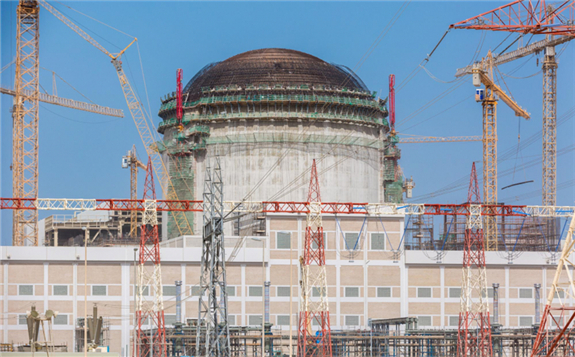In August, the Arab world’s first nuclear power station began to dispatch electricity into the power grid of the United Arab Emirates. The first megawatts of clean electricity were dispatched from the plant to the nation once Unit 1 was connected to the power grid.

Bringing the Barakah nuclear power plant online was a long-awaited milestone in a journey that began in 2007 when an interagency task force was mandated to formulate a strategy to address the looming power shortfall in Abu Dhabi.
The milestone was achieved as part of the power ascension test of the first reactor, which is an important step towards commercial operations.
The $24bn power station consists of four units that will supply 5,600 megawatts of energy – enough to meet 25 per cent of the country’s electricity needs. It will help prevent the release of 21 million tonnes of carbon emissions each year, which is equivalent to removing 3.2 million cars from the roads each year.
The success of UAE’s nuclear power plant is expected to set a new trajectory for neighbouring states and GCC countries that have already set ambitious targets for clean energy.
Nuclear electricity generation capacity in the Middle East is expected to increase from 3.6 gigawatts (GW) in 2020 to 14.1 GW by 2028 because of new construction starts and recent agreements between Middle East countries and nuclear vendors.
The growth in nuclear capacity in the Middle East is largely attributable to countries in the region seeking to enhance energy security by reducing reliance on fossil fuel resources. Fossil fuels accounted for 97% of electricity production in the Middle East in 2019, with natural gas accounting for about 66% of electricity generation and oil for 31%. The remaining 3% of electricity generation in Middle East countries comes from nuclear, hydroelectricity, and other renewables.
Middle East countries are also adopting nuclear generation to meet increasing electricity demand resulting from population and economic growth. Regional electricity production was more than 1,000 billion kilowatthours (kWh) in 2019, and EIA expects electricity demand to increase 30% by 2028, based on projections in the latest International Energy Outlook.
This growth rate is higher than the average global growth rate of 18% over that same period, and higher than the 24% expected growth in non-OECD (Organization for Economic Cooperation and Development) countries.
Saudi Arabia says it plans to issue a multi-billion-dollar tender in 2020 to construct its first two nuclear power reactors and is discussing the project with U.S. and other potential suppliers, three sources familiar with the plans said.
The world’s top oil exporter wants to diversify its energy mix, adding nuclear power so it can free up more crude for export. But the plans are facing Washington’s scrutiny because of potential military uses for the technology.
Saudi Arabia, which aims to mine for uranium, says its plans are peaceful. But Crown Prince Mohammed bin Salman said in 2018 the kingdom would develop nuclear arms if Iran did.
U.S., Russian, South Korean, Chinese and French firms are in talks with Riyadh to supply reactors, a promising deal for an industry recovering from the 2011 Fukushima nuclear disaster.
“Saudi Arabia is continuing to make very deliberate steps forward although at a slower pace than originally expected,” one of the sources familiar with the plans told Reuters.
Saudi officials previously said they aimed to select a vendor in late 2018, which then slipped to 2019. The sources said the tender would now be issued in 2020.
Two sources say the project is proceeding slowly partly because the kingdom was still in discussions with all potential suppliers rather than narrowing them down to a short list.
Riyadh needs to sign an accord on the peaceful use of nuclear technology with Washington to secure the transfer of U.S. nuclear equipment and expertise, under the U.S. Atomic Energy Act. U.S. Energy Secretary Rick Perry said last week that the negotiations which began in 2012 were continuing.
Washington has also been seeking to convince Riyadh to sign the International Atomic Energy Agency’s Additional Protocol on extra safeguards for verifying nuclear technology is used for peaceful applications. The kingdom has so far resisted, the source added.
The fate of these negotiations could determine whether Riyadh reaches a deal with U.S. firms, the source said.
Saudi Arabia, which sent a “request for information” (RFI) to nuclear vendors in 2017, is holding workshops with vendors from five nations as part of the pre-tender process, one source said, adding that this was expected to last 12 to 15 months.
The King Abdullah City for Atomic and Renewable Energy (KACARE), tasked with developing the nuclear program, has brought in an executive from oil giant Saudi Aramco to help manage the pre-tender consultancy process, two sources said.
KACARE has in the past said the kingdom was considering building 17.6 gigawatts of nuclear capacity by 2032, requiring about 16 reactors. But the sources said the focus for now was on the first two reactors and a potentially smaller program.
Iran, across the Gulf, has a nuclear plant in operation and has been locked in a row over its nuclear ambitions with the United States.
Saudi Arabia, which has long vied with Iran for regional influence, has said it will not sign any deal with the United States that deprives the kingdom of the possibility of enriching uranium or reprocessing spent fuel in the future, both potential paths to a bomb.
South Korea’s state-owned Korea Electric Power Corp (KEPCO), Russian state nuclear group Rosatom, French utility EDF, state-run China National Nuclear Corp and U.S. Westinghouse have expressed interest in the Saudi project.